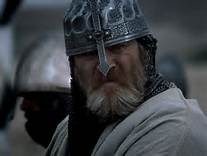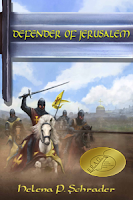Less
than a half century after the re-capture of Jerusalem by Christian
forces, the new crusader states suffered their first set back. In 1144,
the Principality of Edessa was captured by Saracen forces. By 1146 the
Principality of Antioch was also threatened, and an appeal went out. The appeal was made not to the Byzantine Emperor, who was deemed untrustworthy by the Latins at this time, but to the
West. It had been the Latin world that had provided the forces that had taken Jerusalem in 1099;
it was with the ruling elites in above all in France, England and the Holy Roman Empire that the nobles of Outremer retained cultural, linguistic and family
ties.
This
call for help elicited an enthusiastic response. For
the first (but not the last) time, kings
were persuaded to take the cross (i.e., the crusader vow). The
Holy Roman Emperor, Conrad III, and the King of France, King Louis VII,
both promised to raise armies to come to the aid of the Holy Land. Their efforts have gone down in history as the "Second Crusade."
Conrad, the Holy Roman Emperor, raised about 80,000 troops and set out
first. The French left later with an estimated 100,000 men. Notably, however,
when the King of France knelt before Bernard of Clairvaux to take his
crusader vows, he was joined by his queen, Eleanor of Aquitaine, who
likewise knelt and took the cross. Eleanor did so as the Duchess of
Aquitaine and Countess of Poitou – not as Queen of France. The
importance of her gesture was to muster support among the barons and
lords who owed her, but not Louis of France, homage.
However, Eleanor’s example inspired many other French noblewomen to take the cross as well. So when King
Louis’ crusaders set forth on their crusade, his army included an
unnamed number of ladies – or “amazons” as some liked to call them –
determined to take part in the crusade themselves. Most of these women
were the wives of noble crusaders, wealthy enough to afford horses and
armor, since according to a Greek chronicler writing some fifty years
after the event, they rode astride and wore armor. They were also
accompanied by servants and a great deal of baggage.

The first
stages of this crusade went remarkably well for the French, with the
army making good progress. Although accounts differ on the extent to
which Louis was able to prevent pillaging and abuse of the civilian
population along the route, it is clear that the French intention was to
pay for provisions and leave the Christian populations in peace.
Unfortunately, the German crusaders under Conrad
III had behaved rather more badly when they passed through ahead of the French
so that the French often found the cities closed to them, and the price for
goods exorbitant.
Nevertheless, the French reached
Constantinople in comparatively good order, and while the common
soldiers encamped outside the walls, the nobles, including Eleanor and
her ladies, were introduced to the luxuries and splendors of the fabled
Queen of Cities. They were lodged in palaces the like of which they had
never seen before. They were feted and entertained.

The news that the
Byzantine Emperor had just concluded a 12 year truce with the Turks,
however, cast serious doubts upon his reliability. The mistrust of the
Greeks only increased when the Byzantine Emperor tried to make Louis
swear to turn over any territories his army conquered to the Emperor.
Louis thought he had come to fight the Turks and restore Christian rule –
not expand the borders of the Byzantine Empire. Nevertheless, Louis
rejected calls by some of his advisors to capture Constantinople and
depose the Greek emperor. Instead he set out for Jerusalem determined
to fulfill his crusading vow – and consult with the King of Jerusalem
about further action.
Louis
chose to proceed along the southern, coastal route at a leisurely pace
until, at the end of October, his army encountered deserters from the
German crusade. These reported that the Turks had all but annihilated
the Germans and now lay in wait for the French. A few days later, the
French caught up with what was left of the Germans, including Emperor
Conrad, who was suffering from a head wound. Together Louis and Conrad’s
crusaders followed the Mediterranean coast, finally reaching Ephesus in
time for Christmas. Here, however, Conrad decided he was too ill to
continue, so he and his nobles took ship back for Constantinople, while
what was left of the foot soldiers continued with Louis’s army.
No
sooner had the German Emperor departed, than adversity struck the
French. Torrential rains lasting four days washed away tents, supplies,
and many men and horses. After this catastrophe, Louis elected to strike
out inland across the mountains, despite the absence of guides, in an
attempt to reach Antioch as soon as possible. This route, however, crossed through rugged terrain and along bad roads, where the French were constantly harassed by Turkish raiders. By now, at the
latest, the “gayness and the gilt” of Eleanor and her lady-crusaders (or
amazons) were “all besmirched with rainy marching in the painful
field.”
 |
| The quote is from Shakespeare's "Henry V." Above Kenneth Brangh in the title role. |
Disaster,
however, did not overtake them until mid-January, when the commanders of the van took fatal independent action. They had
been ordered to set up camp for the main army at a specific place, and
Eleanor was sent with them. (Throughout the crusade, King Louis
maintained separation from Eleanor in order not to be tempted to break
his vow of chastity during the duration of the crusade.) When the main
army reached the designated camp, however, they found it empty. The
vanguard with the Queen had decided to move to a more
attractive-looking spot down in the valley. The exhausted troops at the
rear, including the King with Eleanor’s baggage train, could not
possibly catch up and as darkness fell a large gap had been opened
between the Christian forces. The Turks quickly exploited the situation.
They attacked the main force. The fighting was so intense and close that Louis’ horse was killed under him. Chronicles claim that some
7,000 crusaders died before darkness fell, putting an end to the slaughter.
Many in the army blamed Eleanor, because it was one of her most important vassals who had left
the main French army in the lurch.
After this disaster, the
French returned to the coast, now determined to continue the crusade by
ship. They were without supplies, however, and soon reduced to eating
their horses before what was left of Louis’ force finally reached
Antalia on January 20, 1148. Here they discovered it was impossible to
find sufficient ships for the whole force at prices King Louis was
willing to pay. Plague broke out in the crusader camp, decimating a
force already on the brink of starvation. At this junction, King Louis
VII (not to be confused with his namesake and future saint, Louis IX)
abandoned his troops and took ship with his wife and nobles for Antioch.
Abandoned by their king, some 3000 French crusaders are said to have
converted to Islam in exchange for their lives and food.
Louis
and Eleanor, meanwhile, arrived in Antioch. Antioch was a magnificent,
walled city, which had been one of the richest in the Roman Empire. At
this time it was inhabited by a mixed population of Greek and Armenian
Christians ruled by a Latin Christian elite, headed by Raymond of
Poitiers, the younger brother of Eleanor’s father, William Duke of
Aquitaine. The language of the court at Antioch was Eleanor’s own langue
d’oc, and the customs were likewise those of the Languedoc. Within a
very short time, Eleanor and her uncle developed such rapport that the
king became jealous and then suspicious. The clerical chroniclers are
united in condemning Eleanor of forgetting her “royal dignity” – and her
marriage vows.

The situation was aggravated by the fact that
Raymond of Antioch thought the crusaders had come to restore Christian
control over the county of Edessa – and so secure his eastern flank. Louis, in contrast, thought he had come on pilgrimage to Jerusalem and insisted on
continuing to the Holy City, rather than following the Prince of
Antioch’s military advice. At this junction, with Louis already jealous
of Eleanor’s close relationship (sexual or not) with Prince Raymond, she
announced that she – and all her vassals – would remain in Antioch,
whether the King of France went to Jerusalem or not. Since her vassals made up the bulk
of what was left of the French forces, this was an effective veto. Louis
threatened to use force to make her come with him as was his right as
her husband. Eleanor retorted their marriage was invalid because they
were related within the prohibited degrees and demanded an annulment.
Louis responded by having her arrested in the middle of the night and
carried away from Antioch by force.
After the French King's
arrival in Jerusalem, the crusaders, local barons and military orders
met to decide on the best strategy for action against the enemy.
Although the author of the decision is not clear, the fateful decision
was made to try to seize Damascus. The logic was that this would relieve
the pressure on the narrowest part of the crusader kingdom -- the lands
between Tyre and Tripoli. Ironically, the Muslim ruler of Damascus was
one of the Saracen leaders, who had been willing to compromise and
negotiate with the crusader kingdoms. The siege made an
enemy of a former ally and pushed him into the arms of the jihadists --
which wouldn't have been disastrous if the campaign had been successful.
However, although a siege was established, squabbles among the leaders
and then news that a strong Saracen relief army was on the way spread
so much panic among the crusaders that the crusading army disintegrated.
They had made a new enemy for nothing and squandered the reinforcements
from the West.
Worst of all, however, was that this humiliating failure
profoundly damaged the entire concept of crusades and crusading in the
West. It demonstrated that “God” was not inherently on the side of the
crusaders and that victory was not assured. It also helped restore both
unity and confidence among the Saracen leaders.
As
a footnote, Queen Eleanor spent the months in Jerusalem while her
husband’s crusade came to its final humiliating end outside
Damascus. Although nothing is recorded of her activities, clearly her
influence on Louis and her role in the crusade was over. Furthermore,
despite an attempt to patch up the marriage after their return to
France, the birth of a second daughter made a divorce a dynastic
priority. Louis abrogation of Eleanor, however, paved the way for her
to marry Henry of Anjou, the future King Henry II of England. Eleanor's
rich lands were instrumental in giving the Plantagenet king the means
to challenge the Capets for dominance on the continent of Europe throughout the next half-century.
 |
|
Dr. Helena P. Schrader holds a PhD in History.
She is the Chief Editor of the Real Crusades History Blog.
She
is an award-winning novelist and author of numerous books both fiction
and non-fiction. Her three-part biography of Balian d'Ibelin won a total
of 14 literary accolades. Her most recent releases are a novel about the
founding of the crusader Kingdom of Cyprus and a new series on the baronial revolt against Frederick II.







































